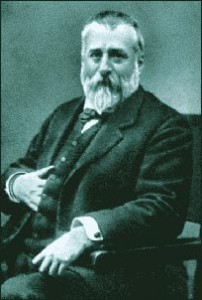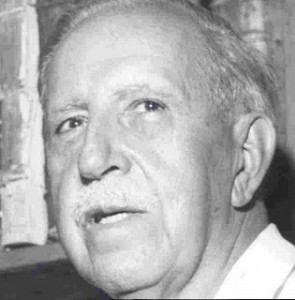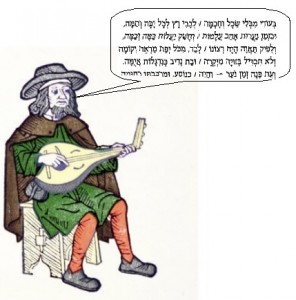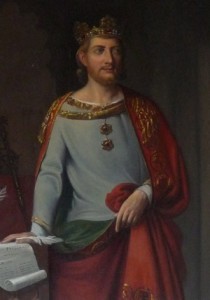[This post includes material later revised and expanded in Double Diaspora in Sephardic Literature: Jewish Cultural Production before and after 1492 (Indiana University Press, 2015)]
In a previous post I discussed two poems of Todros Abulafia in the context of the troubadour poetry of his day. This post is the text of an academic conference paper that grew out of the previous post on Abulafia. I presented this paper at this year’s meeting of the Mid-America Medieval Association (MAMA) in Kansas City, Missouri (26 Feb 2011). Your comments are welcome. You can also view this paper as a slidecast (slides + audio) in .mov format.
MLA Citation format: Wacks, David A. Recycling the Troubadours in Hebrew: Todros Abulafia, Hebrew Troubadour at the Court of Alfonso X. 35th Annual Meeting of the Mid-America Medieval Association (MAMA). University of Missouri, Kansas City. 26 February 2011. Conference paper.
Many of you know a lot about trouabadour poetry – in fact most of you probably know a lot more about it than I will ever know. But I’ll bet that fewer of you are familiar with the activities of the troubadours in Spain, and even fewer with the Hebrew poets of Spain, and that is where I would like to take you today, to the crossroads of medieval Hebrew and troubadour poetry, in Toledo, Spain, in the late thirteenth century. The Hebrew poet in question is named Todros ben Meir Halevi Abulafia. We’ll call him Abulafia. He was a notable of the Jewish community of Toledo, which at the time was a very well established community boasting a centuries long history. During Muslim rule, Jewish courtiers had served the Muslim rulers of Tulaytula, and after the Christian conquest, under Christian monarchs as well.
Abulafia was active at the court Alfonso the tenth of Castile, known as ‘the Learned,’ who reigned from 1252-1284. During Alfonso’s reign there were several court Jews who served as financiers, outfitters, tax farmers, and the like. He himself served Alfonso as a tax farmer and was a sort of notorious man about town, womanizer, and partier who did not hesitate to report on, and probably embellish, his exploits in his poetry. Aside from his choice of language, what sets Abulafia apart from his counterparts writing in Provencal and Galician-Portuguese is Todros’ status as a member of a diasporic religious minority. As such, he is oriented toward two symbolic centers: the biblical homeland of Zion, or Palestine, and the ancestral hostland of Sefarad, the Hebrew word for the Iberian Peninsula. This dual orientation is helpful in understanding why he writes in Hebrew, and how he adapts contemporary poetic practice into his verse.
In al-Andalus, which is the Arabic word for the Iberian Peninsula, the Jewish elites participated quite fully in secular intellectual culture. They received classical Arabic educations, mastered the works of the Arab poets, and wrote treatises on philosophy, the sciences, even Jewish exegesis, in classical Arabic. They were on equal footing with their Muslim and Christian peers in the official language of the dominant culture, a language that boasted a very prestigious poetic tradition spanning centuries and drawing on the brightest minds of the Muslim world, which at the time reached from The Atlantic in the West to the Indus River in the East.
The ideology that underpinned Jewish participation in the dominant poetic culture of Islam was the Quranic doctrine of dhimma, or protected religious minorities. Under Islam, Jews and Christians were guaranteed the right to practice their religions, provided they paid the jizya, or poll tax, and complied with certain social and economic restrictions. Like any other doctrine, it was applied variously and was in no way a blanket guarantee of the well-being of every Jew or every Christian in a Muslim kingdom, but it did provide a robust juridical framework for the treatment of Jews and Christians in al-Andalus, and justified their participation in all aspects of public life excepting Islamic scholarship and leadership.
In the sphere of literature this meant that Jewish writers in al-Andalus were active at court in the dominant language of the court. This included poetry, and Jewish poets were regularly included in medieval anthologies of Andalusi poetry.This is the diasporic moment in al-Andalus, when Sephardic poets begin to adapt Arabic poetic practice in Hebrew, and invent a diasporic poetics with a double orientation: the symbolic homeland Zion gave them their words, drawn directly from the Hebrew Bible. Their hostland al-Andalus gave them another layer of poetics, and they drew freely and effortlessly from the Andalusi repertory of imagery, rhetorical figures, metrics, and poetic practice. The result was a thickly intertextual, intercultural poetic corpus. For Jewish audiences, Andalusi Hebrew poetry resonated with both the synagogue and the court.
This is the poetic tradition that Abulafia inherited. However, he lived in Christian Iberia and worked at the court of a Christian monarch. Under Christianity, the situation was different. Unlike their Andalusi grandparents, Sephardic Jews under Christian kings were not typically familiar with the classical language of the dominant culture. In the 13th century, even in the face of the vernacular revolution taking place at the court where Abulafia worked, Latin was the prestige classical language, the language of the Church and of most intellectual activity in Western Christendom. Sephardic Jews were not a part of this activity.
In the context of Christian government, the Andalusi literary legacy of Sephardic Jews was foreign. Prestigious, perhaps, but ultimately foreign to the great majority of Christian elites, who valued Arabic learning but were most likely to consume it in Latin or Castilian translations. The diasporic moment had changed, and the cultural terms of engagement needed to be renegotiated.At this very moment of renegotiation, a new Romance vernacular poetic practice is emergent in Castile. Just as Sephardic poets are no longer practitioners of the dominant intellectual tradition, they are becoming practitioners of the emergent poetic tradition, by virtue of their romance-language nativity. While to us this may seem like a boon, to them it was a conundrum. Before Abulafia’s time, Andalusi Jewish were both connoisseurs and producers of Arabic poetry. Nonetheless, when writing in Hebrew they sometimes made a show of denigrating Arabic tradition, in an effort to exalt Hebrew.
In the Andalusi context this bluster was mostly a rhetorical trope that authors deployed as a kind of accessus in introductions to works Hebrew poetry and prose. Though motivated by a kind of linguistic proto-nationalism, it was ultimately the kind of good-natured brinksmanship one might read in medieval debate poetry of any tradition. But in Christian Iberia, this exaltation of Hebrew poetics took on a new urgency, now that Sephardic intellectuals were estranged from the dominant intellectual tradition. It may well have been sour grapes: in Toledo, for example, between the Christian conquest of 1085 and the beginning of the reign of Alfonso X in 1252, there was no thriving poetic scene in which a Jewish poet might participate. By the late thirteenth century, Poetic production in Arabic outside of Granada and Valencia had virtually ceased, and Sephardic poets had not, for whatever reason, taken to composing courtly poetry in the vernacular.
Even Abulafia, whom his Jewish peers considered a notorious assimilationist and who did not hesitate to socialize, and fraternize, with Christians, he did not, as far as we know, compose in the vernacular. For him it is not really an option to adopt the poetic language of the moment. Perhaps the vernacular had not yet achieved enough prestige or historical weight for Jewish poets to adopt it wholeheartedly. It may be that Jewish poets, as a diasporic minority, felt insecure about adopting the dominant poetic language because they had no history of participating in Latin intellectual life. Perhaps the admonishments of their grandparents’ generation kept them away. In any event, it was not happening.
Abulafia’s renegotiation of the Sephardic diasporic poetics was going to be different. And, while he did not compose in the vernacular he did participate in vernacular poetics. By this I mean that he expressed his orientation toward hostland poetics by adapting the themes, habits of expression, and poetic ideologies of his peers who composed in the Romance vernaculars. As we will see, Todros creates a new poetic voice that grows naturally from both the Andalusi Hebrew and vernacular troubadour traditions of courtly love. Some of this innovation is original and probably unrelated to what was going on in vernacular troudabour poetry. Todros was very creative in his use of the stock imagery and poetic strategies of Andalusi Hebrew tradtion. But in some cases it is very clear that he is in some ways, a Hebrew troubadour.
This should come as no surprise, as Alfonso’s court was an important center of troubadour poetry. Some of the poets that served at his court include Bonifaci Calvo, Arnaut Catalan, Guiraut Riquer, Peire Cardenal, Cerverí de Girona, and Airas Nunes (Alvar 1977; O’Callaghan 1993: 144). Alfonso regularly employed troubadours as a sort of propaganda corps. Galician-Portuguese troubadours regularly promoted Alfonso’s various political projects on the peninsula, while those writing in Provencal publicized designs on the Holy Roman Imperial throne (Beltrán 2006: 155-56).
On a more formal and specific level, Abulafia adapted some of the same generic conventions used by the troubadours. The Spanish hebraist Ángel Sáenz-Badillos (1996) has demonstrated that some of Abulafia’s invective poetry is structurally and thematically very similar to the tensós and sirventeses of the troubadours among whom he moved at court. The one critic to thoroughly tackle the question of Todros’ involvement with vernacular poetics is Aviva Doron, who in 1989 published a Hebrew language monograph titled A Poet in the King’s Court (Incidentally, in the entire WorldCat system, only a single copy of Doron’s book is available, from Karl Ebershard University in Germany).
Doron deals with a few different aspects of Abulafia’s work, focusing mainly on his poems dedicated to Alfonso and his love poetry. Her main points of reference are Carlos Alvar’s books on troubadouresque poetry in Spain. She makes some interesting points about Abulafia’s take on courtly love, but I would like to build on her observations today and go into more specific detail about how Abulafia’s poetry is in dialogue with the troubadouresque discourse of courtly love. His adaptation of the conventions of fin’amors is where he is at his most innovative, and where he least resembles his predecessors in Hebrew poetry.
Two of his poems in particular, numbers 714 and 715 in the authoritative 1932 Hebrew edition of David Yellin express a number of aspects of courtly love unique to troubadouresque fin’amor and absent from Andalusi Hebrew tradition. In order to better make my point, I choose examples almost exclusively from Provencal and Galician-Portuguese troubadours who also wrote at Alfonso’s court and who may well have known Todros and perhaps even written and recited alongside (or in competition) with him. I have selected a series of quotes expressing commonplaces of troubadouresque fin’amor, or courtly love. In each case, Abulafia follows the lead of the troubadours very closely, and in the final example, as we will see, he takes it to the next level.
In this first example, Bonifacio Calvo, an Italian who wrote in Provencal, performs a standard heresy of courtly love in which he imagines God himself falling in love with his beloved:
Que si plagues amar a dieu / Dompna del mon, avinen plai / Auri’ en leis, que chausid ai (‘if it pleased God to love a woman of the world, he would have a pleasant delight in her whom I have chosen’) (ed. Horan 1960: 34, no. 5, vv. 30-32; trans. Horan 1960: 36)
Abulafias’s heresy is a bit more complex. He imagines a cult of his beloved complete with holidays and a Temple:
My soul celebrates her as a holiday! See how, for her sake my soul sings the name of God! / And so on this holiday I will visit her Temple, and perhaps I will steal a word from her! (no. 715, vv. 9-10)
How will I ever choose another, while God himself exalts her? (no. 715, v. 18)
Another commonplace of the fin’amor of the troubadours is the emphasis on the nobility of all aspects of the beloved: her lineage, her conduct, her very soul. Calvo’s example focuses on the conduct of his dompna, or lady:
E·l sieus hontraz chapteners / Es tant genzer dels gensors (‘her honored conduct is so much more noble than the noblest’) (ed. Horan 1960: 24, no. 1, vv. 36-37, trans. Horan 1960: 25)
Abulafia’s example contrasts his indiscrete younger self with his more mature self who realizes the values of nobility in a beloved. Borrows a phrase from the Song of Songs to describe the beloved as an army bearing a standard. It is common in Andalusi Hebrew poetry to describe the beloved using martial imagery, and here Abulafia gives it a courtly twist that is probably reminiscent of the banners used in knightly tournaments. The second example describes three aspects of his lady’s nobility: lineage, and soul:
[When I was young and foolish] I did not distinguish between commoner and high born, or even the daughter of a nobleman, terrible with banners (Song 6:4) (no. 714, v. 4)
I fell in love with a real damsel, an honorable girl, with a noble soul (no. 714, v. 7)
One of the characteristics of the courtly lover is refined, eloquent, morally correct speech. All three of our poets describe this in their ladies:
Pero García Burgalés:
Qual dona Deus fez melhor parecer
e que fezo de quantas outras son
falar melhor, e en melhor razon
(Jensen 1992: 308, no. 45, cantiga 1, vv. 1-3)‘the lady whom God gave greater beauty,
and whom he endowed with more eloquent and judicious speech, than all the other ladies in the world
(trans. Jensen 1992: 309, no. 45, cantiga 1, vv. 1-3)Bonifacio Calvo:
Sos senz e sas granz lauzors (ed. Horan 1960: 25, vv. 36-37)
(‘for her noble speech, [and] her intelligence’) (trans. Horan 1960: 25)
In Abulafia’s case, his lady’s speech is so pure that it motivates and upflits:
“her speech raises up the fallen” (no. 714, v. 20)
Particular to troubadouresque fin’amor is the idea that spiritual love is enough to sustain the lover, who might even prefer to desire the mere idea or memory of his beloved, or perhaps to simply see her or hear her voice, without the possibility of physical union. In this example, Peire Cardenal, writing in Provencal, declares that he actually prefers desire over physical love:
voil ades mais desirar
Que tener ma dona e baisar
‘I still prefer to desire [her]
than to hold my lady and kiss [her]’
(ed. Lavaud 1957: 24, no. 5, vv. 2-3)
Que, ja plazer no-m fezés
Eu fora sos homs adès
‘Though she never grant me pleasure,
I should still be her man forever!’
(ed. Lavaud 1957: 16, no. 3, vv. 12-13)
Abulafia likewise is happy (or happily miserable) to pine away without actually touching his lady, and espouses (at least in this verse) a purely spiritual, hands-off kind of love:
I shall not think ever to touch her
even though I spend my life sobbing over her
(ed. Yellin no. 714, v. 15)I have no desire to have her, to delight in her body,
only to delight in her soul
(no. 714, v. 21)
In these final texts, I’d like to show you an example of how Abulafia sometimes takes fin’amor to the next level. In this case, he elaborates and builds upon a courtly love trope found in one poem of Pero García Burgalés: that of the skeptic converted, the naysayer who scoffs at the poet’s dedication and suffering, but who, when faced with the irresistible beauty and nobility of the lady in question, finds himself equally if not more enthralled. In this cantiga, Burgalés imagines what would happen to the skeptic if he should be so lucky to catch a glimpse of the poet’s lady:
Ca ben sei eu, u outra ren non á,
que tal esforç’ averá qual eu ei
quando a vejo, que per ren non sei
que lhi dizer: e el assi fará!
Se per ventura lhi dizer quiser
algũa ren, ali u estever
ant’ ela, todo lh’ escaecerá!
(ed. Jensen 1992: 308, cantiga 1, vv. 22-28)
For I know for certain, that, where nobody else is present,
he will have the same courage I do,
when I see her, for I do not in any way know
what to say to her then: and the same thing will happen to him!
If, by chance, he wanted to tell her
something, as soon as he finds himself
in her presence, everything will slip from his mind!
(trans. Jensen 1992: 309, cantiga 1, vv. 22-28)
In this poem of Abulafia it seems as if he is responding directly to Burgalés, elaborating and dramatizing an entire scene, complete with dialogue, using Burgalés’ verses as an outline. The poet and the skeptic are in the middle of a heated exchange over the futility of the poet’s unrequited love, when the lady herself happens by, trailing with her a cloud of perfume, and illuminating the dark night with her radiance. As you can see, the skeptic is completely won over, and his exuberance exceeds even that of the poet himself in these final verses. I’ll let Abulafia speak for himself here….
When he saw her, even as he spoke ill of her,
His soul began to enter into her light…
Suddenly, his soul was bound to hers
And his heart was locked in the heart of her prison
And even the splendor of her cheek, in its radiance, prevented
his pupils from looking upon her brilliance
The I fell upon my face, and my soul
was like a woman in her first childbirth who fears the pain
And I would have died, had he not
Reminded me of her, and I woke up thinking of her,
When he said: “What is with you, sleeper? (Jonah 1:6) Look: There goes ‘that certain lady,’ Arise! Behold her beauty!
I give praise and confess to your beloved hind,
I am her ransom and her sacrifice!
Truly, it is enough for the man who loves her
to see her or to hear her words!
It is doctrine for every nobleman to make his life
a treadstone for her, and to lick the dust from her foot!
To suffer completely for her love,
for truly then God shall multiply her reward!
I shall set my heart to serve my love for her for ever
Never shall I ask for her to set me free!
As long as the sun rises in the East, or
As long as the birds sing of her!”
Conclusions
- I think that these examples speak for themselves quite well, and from them I believe we can take away three conclusions:
- Neither Abulafia’s religion nor his choice of poetic language prevented him from participating in vernacular poetic practice, even if Abulafia was not composing in the vernacular.
- While much of Abulafia’s divergence from Andalusi poetic conventions were idiosyncratic, in some poems, his discourse of courtly love bear clear influence of contemporary troubadours who worked at the court with him.
For a diasporic writer working between a diasporic classical tradition and an emergent vernacular tradition, the question of influences is not a zero sum game. This is typical of any case of cultural production where an artist is drawing on more than one linguistic or religious tradition. The Sephardic case is distinct only in the specifics, but there is nothing structurally unique about Abulafias position as a diasporic poet.
While far from exhaustive, I believe the examples we have seen today are sufficient to demonstrate Abulafia’s participation in the troubadour poetics of his day in Alfonso’s court. He has moments of unadulterated fin’amor (pun intended) cast in Hebrew, giving expression to a vernacular love aesthetic in a classical language that is unknown to his peers composing in the vernacular. His is a uniquely diasporic poetics in which the voices of troubadours, Andalusi poets and Biblical prophets echo back and forth in time, and across the mediterranean.
Bibliography
- Abulafia, Todros Ha-Levi ben Yehudah. The Garden of Parables and Saws, A Collection of Poems [Hebrew]. Jerusalem, 1932.
- Alvar, Carlos. La poesía trovadoresca en España y Portugal. Madrid: Editorial Planeta; Real Academia de Buenas Letras, 1977.
- Alvar, Carlos, and Vicente Beltrán, eds. Antología de la poesía gallego-portuguesa. Madrid: Alhambra, 1985.
- Beltran, Vicenç. “Trovadores en la corte de Alfonso X.” Alcanate: Revista de estudios Alfonsíes 5 (2006): 163-190.
- Calvo, Bonifacio. The poems of Bonifacio Calvo a critical edition. Ed. and Trans. Robert Horan. The Hague: Mouton, 1966.
- Cardenal, Peire. Poésies complètes du troubadour Peire Cardenal (1180-1278). Ed. René Lavaud. Toulouse: É. Privat, 1957.
- Doron, Aviva. A Poet in the King’s Court: Todros Halevi Abulafia, Hebrew Poetry in Christian Spain [Hebrew]. Tel Aviv: Dvir, 1989.
- Jensen, Frede. Medieval Galician-Portuguese Poetry: An Anthology. New York: Garland, 1992.
- O’Callaghan, Joseph F. The Learned King: The Reign of Alfonso X of Castile. Philadelphia: University of Pennsylvania Press, 1993.
- Sáenz-Badillos, Ángel. “Hebrew Invective Poetry: The Debate Between Todros Abulafia and Phinehas Halevi.” Prooftexts 16 (1996): 49-73.











